Pope Pius V
Pope Pius V (17 January 1504 – 1 May 1572), born Antonio Ghislieri (from 1518 called Michele Ghislieri, O.P.), was head of the Catholic Church and ruler of the Papal States from 8 January 1566 to his death in 1572. He is venerated as a saint of the Catholic Church.[2] He is chiefly notable for his role in the Council of Trent, the Counter-Reformation, and the standardization of the Roman Rite within the Latin Church. Pius V declared Thomas Aquinas a Doctor of the Church.[3][4]
Pope Saint Pius V | |
|---|---|
| Bishop of Rome | |
| Papacy began | 7 January 1566 |
| Papacy ended | 1 May 1572 |
| Predecessor | Pius IV |
| Successor | Gregory XIII |
| Orders | |
| Ordination | 1528 by Innocenzo Cybo |
| Consecration | 14 September 1556 by Giovanni Michele Saraceni |
| Created cardinal | 15 March 1557 by Pope Paul IV |
| Personal details | |
| Birth name | Antonio Ghislieri |
| Born | 17 January 1504 Bosco, Duchy of Milan |
| Died | 1 May 1572 (aged 68) Rome, Papal States |
| Previous post |
|
| Motto | Utinam dirigantur viæ meæ ad custodiendas justificationes tuas (O that my ways may be directed to keep thy justifications)[1] |
| Coat of arms |  |
| Sainthood | |
| Feast day |
|
| Venerated in | Catholic Church |
| Beatified | 1 May 1672 by Pope Clement X |
| Canonized | 22 May 1712 by Pope Clement XI |
| Attributes |
|
| Patronage |
|
| Other popes named Pius | |
As a cardinal, Ghislieri gained a reputation for putting orthodoxy before personalities, prosecuting eight French bishops for heresy. He also stood firm against nepotism, rebuking his predecessor Pope Pius IV to his face when he wanted to make a 13-year-old member of his family a cardinal and subsidize a nephew from the papal treasury.[5]
By means of the papal bull of 1570, Regnans in Excelsis, Pius V excommunicated Elizabeth I of England for heresy and persecution of English Catholics during her reign. He also arranged the formation of the Holy League, an alliance of Catholic states to combat the advancement of the Ottoman Empire in Eastern Europe. Although outnumbered, the Holy League famously defeated the Ottomans at the Battle of Lepanto in 1571. Pius V attributed the victory to the intercession of the Blessed Virgin Mary and instituted the feast of Our Lady of Victory.[6] Biographers report that as the Battle of Lepanto ended, Pius rose and went over to a window, where he stood gazing toward the East. "...[L]ooking at the sky, he cried out, 'A truce to business; our great task at present is to thank God for the victory which He has just given the Christian army'."[5]
Biography
Early life
Antonio Ghislieri was born 17 January 1504 in Bosco in the Duchy of Milan (now Bosco Marengo in the province of Alessandria,[7] Piedmont), Italy. At the age of fourteen he entered the Dominican Order, taking the name Michele, passing from the monastery of Voghera to that of Vigevano, and thence to Bologna. Ordained a priest at Genoa in 1528, he was sent by his order to Pavia, where he lectured for sixteen years. At Parma he advanced thirty propositions in support of the papal chair and against the Protestant Reformation.
He became master of novices and was on several occasions elected prior of more than one Dominican priory. During a time of great moral laxity, he insisted on discipline, and strove to develop the practice of the monastic virtues. He fasted, did penance, passed long hours of the night in meditation and prayer, traveled on foot without a cloak in deep silence, or only speaking to his companions of the things of God. As his reformist zeal provoked resentment, he was compelled to return to Rome in 1550, where, after having been employed in several inquisitorial missions, he was elected to the commissariat of the Holy Office.
In 1556 he was made Bishop of Sutri by Pope Paul IV and was selected as inquisitor of the faith in Milan and Lombardy. In 1557 he was made a cardinal and named inquisitor general for all Christendom.[5] His defense of Bartolomé Carranza, Archbishop of Toledo, who had been suspected of heresy by the Spanish Inquisition, earned him a rebuff from the pope.[8]
Under Pope Pius IV (1559–65) he became Bishop of Mondovi in Piedmont. Frequently called to Rome, he displayed his unflinching zeal in all the affairs on which he was consulted. Thus he offered an insurmountable opposition to Pius IV when the latter wished to admit Ferdinand de' Medici, then only thirteen years old, into the Sacred College. His opposition to the pontiff procured his dismissal from the palace and the abridgment of his authority as inquisitor.[9]
Papal election
Before Michele Ghislieri could return to his episcopate, Pope Pius IV died. Cardinal Borromeo wrote to the Portuguese cardinal Henrique six weeks following the conclave where he recalled the election of the new pope. The cardinal referred to having "a high esteem for him on account of his singular holiness and zeal" and saw these qualities as a signal that he would make a good pope "to the great satisfaction of all". On 4 January, a courier from Spain arrived prompting rumors that King Philip II endorsed Cardinal Ghislieri, giving Borromeo and his allies the chance to capitalize on the confusion. This led to an increase in votes for Ghislieri as the cardinals conferred with each other, leading to the election of the new pope in the afternoon of 8 January.[10]
On 8 January 1566, Ghislieri, with the influential backing of Charles Borromeo, was elected to the papal throne, taking the name Pope Pius V.[7] He was crowned ten days later, on his 62nd birthday by the protodeacon.
Pontificate
| Papal styles of Pope Pius V | |
|---|---|
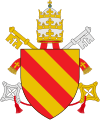 | |
| Reference style | His Holiness |
| Spoken style | Your Holiness |
| Religious style | Holy Father |
| Posthumous style | Saint |
His pontificate saw him dealing with internal reform of the Church, the spread of Protestant doctrines in the West, and Turkish armies advancing from the East.
Church discipline
Aware of the necessity of restoring discipline and morality at Rome to ensure success without, he at once proceeded to reduce the cost of the papal court after the manner of the Dominican Order to which he belonged, compel residence among the clergy, regulated inns, and assert the importance of the ceremonial in general and the liturgy of the Mass in particular.
In his wider policy, which was characterised throughout by an effective stringency, the maintenance and increase of the efficacy of the Inquisition and the enforcement of the canons and decrees of the Council of Trent had precedence over other considerations.[5]
Liturgy
Accordingly, in order to implement a decision of that council, he standardised the Holy Mass by promulgating the 1570 edition of the Roman Missal. Pius V made this Missal mandatory throughout the Latin rite of the Catholic Church, except where a Mass liturgy dating from before 1370 AD was in use.[11][12] This form of the Mass remained essentially unchanged for 400 years until Pope Paul VI's revision of the Roman Missal in 1969–70, after which it has become widely known as the Tridentine Mass;[13] use of the last pre-1969 edition of the Missal, that by Pope John XXIII in 1962, is permitted without limitation for private celebration of the Mass and, since July 2007, is allowed also for public use, as laid down in the motu proprio Summorum Pontificum of Pope Benedict XVI. Some continue to use even earlier editions, but without authorisation.
Thomism
Pius V, who had declared Thomas Aquinas the fifth Latin Doctor of the Church in 1567, commissioned the first edition of Aquinas' opera omnia, often called the editio Piana in honor of the Pope. This work was produced in 1570 at the studium generale of the Dominican Order at Santa Maria sopra Minerva, which would be transformed into the College of Saint Thomas in 1577, and again into the Pontifical University of Saint Thomas Aquinas, Angelicum in the 20th century.[14]
Holy League
Pius V arranged the forming of the Holy League against the Ottoman Empire, as the result of which the Battle of Lepanto (7 October 1571) was won by the combined fleet under Don John of Austria. It is attested in his canonisation that he miraculously knew when the battle was over, himself being in Rome at the time.[15] Pius V also helped financially in the construction of Valletta, Malta's capital city, by sending his military engineer Francesco Laparelli to design the fortification walls. (A bronze bust of Pius V was installed at the Gate of Valletta in 1892.) To commemorate the victory, he instituted the Feast of Our Lady of Victory.
The Protestant Revolt
By the time Pius V ascended the throne, Protestantism had swept over all of England and Scotland, as well as half of Germany, the Netherlands, and parts of France; only Spain remained unswervingly Catholic. Pius V was thus determined to prevent its insurgency into Italy—which he believed would come via the Alps and Milan.
Huguenots
Pius V recognized attacks on papal supremacy in the Catholic Church and was desirous of limiting their advancement. In France, where his influence was stronger, he took several measures to oppose the Protestant Huguenots. He directed the dismissal of Cardinal Odet de Coligny[16] and seven bishops, nullified the royal edict tolerating the extramural services of the Reformers, introduced the Roman catechism, restored papal discipline, and strenuously opposed all compromise with the Huguenot nobility.
Elizabeth I
His response to the Queen Elizabeth I of England assuming position of the Supreme Governor of the Church of England included support of the imprisoned Mary, Queen of Scots and her supporters in their attempts to take over England "ex turpissima muliebris libidinis servitute" "from a most sordid slavery to a woman's voracity". A brief English Catholic uprising, the Rising of the North, had just failed. Pius then issued a Papal bull, Regnans in Excelsis ("Reigning on High"), dated 27 April 1570, that declared Elizabeth I a heretic and released her subjects from their allegiance to her.[17] It was the official decree of excommunication on her and it also declared an ipso facto excommunication on anyone who did not deny allegiance to her. In response, Elizabeth, who had thus far tolerated Catholic worship in private, now actively started persecuting them for treason.
Character and policy
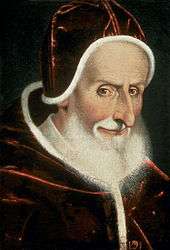
As a young man, Michele Ghislieri was eager to join the inquisition. Under Paul IV, whom popular historian John Julius Norwich calls the most hated pope of the 16th century,[18] he rose to inquisitor general, and from there ascended to the papacy. As Pius V, he personally attended all sessions of the Roman inquisition. According to Norwich, Ghislieri often stayed to watch as supposed lawbreakers and heretics were tortured.[19]
Upon assuming the papacy, Ghislieri immediately started to get rid of many of the extravagant luxuries then prevalent in the court. One of his first acts was to dismiss the papal court jester, and no pope after had one.±[20] He forbade horse racing in St. Peter's Square. Severe sanctions were imposed against blasphemy, adultery, and sodomy. These laws quickly made Pius V the subject of Roman hatred; he was accused of trying to turn the city into a vast monastery. He was not a hypocrite: in day-to-day life Pius V was highly ascetic. He wore a hair shirt beneath the simple habit of a Dominican friar and was often seen in bare feet.[21]
Rev. Alban Butler writes that "In the time of a great famine in Rome, he imported corn at his own expense from Sicily and France [...]; a considerable part of which he distributed among the poor, gratis, and sold the rest to the public below cost."[22]
Papal bulls
Katherine Rinne writes in Waters of Rome[23] that Pius V ordered the construction of public works to improve the water supply and sewer system of the city—a welcome step, particularly in low-lying areas, where typhoid and malaria were inevitable summer visitors.
In 1567 he issued Super prohibitione agitationis Taurorum & Ferarum prohibiting bull-fighting.[24]
Besides "In Coena Domini" (1568) there are several others of note, including his prohibition of quaestuary (February 1567 and January 1570); condemnation of Michael Baius, the heretical Professor of Leuven (1567); reform of the Roman Breviary (July 1568); formal condemnation of homosexual behaviour by the clergy[25] (August 1568); the banishment of the Jews from all ecclesiastical dominions except Rome and Ancona (1569);[26] an injunction against use of the reformed missal (July 1570); the confirmation of the privileges of the Society of Crusaders for the protection of the Inquisition (October 1570); the suppression of the Fratres Humiliati (February 1571); the approbation of the new office of the Blessed Virgin (March 1571); and the enforcement of the daily recitation of the Canonical Hours (September 1571).
Papal garments
Pius V is often credited with the origin of the Pope's white garments, supposedly because after his election Pius continued to wear his white Dominican habit. However, many of his predecessors also wore white with a red mozzetta, as can be seen on many paintings where neither they nor Pius is wearing a cassock, but thin, wide, white garments.
An article by Agostino Paravicini Bagliani on L'Osservatore Romano of 31 August 2013 states that the earliest document that speaks explicitly of the Pope wearing white is the Ordo XIII, a book of ceremonies compiled in about 1274 under Pope Gregory X. From that date on, the books of ceremonies speak ever more explicitly of the Pope as wearing a red mantle, mozzetta, camauro and shoes, and a white cassock and stockings.[27][28]
Canonizations
Pius V canonized one saint during his reign: Ivo of Chartres on 18 December 1570.
Consistories
Pius V created 21 cardinals in three consistories including Felice Piergentile who would become Pope Sixtus V.
Death and canonization
Saint Pope Pius V | |
|---|---|
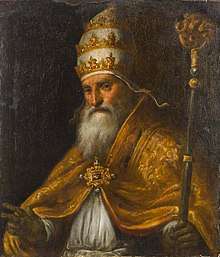 Pius V by Palma il Giovane | |
| Bishop of Rome | |
| Born | Antonio Ghislieri January 17, 1504 Bosco, Duchy of Milan |
| Died | May 1, 1572 Rome, Papal States |
| Venerated in | Catholic Church |
| Beatified | 1 May 1672 by Pope Clement X |
| Canonized | 22 May 1712 by Pope Clement XI |
| Feast | 30 April (Catholic Church) 5 May (pre-1969) |
| Patronage | Valletta, Malta Bosco Marengo, Italy |
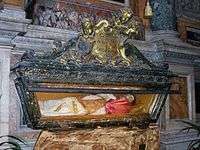
Pius V died on 1 May 1572 of what is believed to be cancer. He was buried in the chapel of S. Andrea which was close to the tomb of Pope Pius III, in the Vatican. Although his will requested he be buried in Bosco, Pope Sixtus V built a monument in the chapel of SS. Sacramento in the Liberian basilica. His remains were transferred there on 9 January 1588.
In 1696, the process of Pius V's canonisation was started through the efforts of the Master of the Order of Preachers, Antonin Cloche. He also immediately commissioned a representative tomb from the sculptor Pierre Le Gros the Younger to be erected in the Sistine Chapel of the Basilica di Santa Maria Maggiore. The pope's body was placed in it in 1698. Pope Pius V was beatified by Pope Clement X in the year 1672,[29] and was later canonized by Pope Clement XI (1700–21) on 22 May 1712.[30][31]
In the following year, 1713, his feast day was inserted in the General Roman Calendar, for celebration on 5 May, with the rank of "Double", the equivalent of "Third-Class Feast" in the General Roman Calendar of 1960, and of its present rank of "Memorial".[32] In 1969 the celebration was moved to 30 April, the day before the anniversary of his death (1 May).
Cardinal John Henry Newman declared that "St. Pius V was stern and severe, as far as a heart burning and melted with divine love could be so ... Yet such energy and vigour as his were necessary for the times. He was a soldier of Christ in a time of insurrection and rebellion, when in a spiritual sense, martial law was proclaimed."[8]
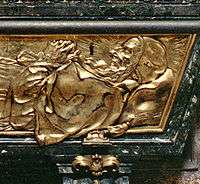
The front of his tomb has a lid of gilded bronze which shows a likeness of the dead pope. Most of the time this is left open to allow the veneration of the saint's remains.
See also
- Cardinals created by Pius V
- List of popes
- List of Catholic saints
- Pope Saint Pius V, patron saint archive
References
- Salvatore, Canonici Regolari di Sant'Agostino Congregazione del Santissimo (1730). "Bullarium Canonicorum regularium Rhenanæ congregationis sanctissimi ... - Canonici regolari di sant'Agostino : Congregazione del santissimo Salvatore - Google Books". Retrieved 17 March 2016."R.P.D. Thomae Del Bene clerici regularis, ... De officio S. Inquisitionis ... - Google Books". 1680. Retrieved 17 March 2016."Ps 118:5 VULGATE;DRA - utinam dirigantur viae meae ad - Bible Gateway". Bible Gateway. Retrieved 17 March 2016.
- Durant, William ‘Will’; Durant, Ethel ‘Ariel’ (1961), Age of Reason Begins, The Story of Civilisation, 7, Simon & Schuster, pp. 238–39
- Thomas Aquinas (1911). "The "Summa Theologica" of St. Thomas Aquinas". 1. New York. Cite journal requires
|journal=(help) - Jan Peil; Irene van Staveren, eds. (1 January 2009). Handbook of Economics and Ethics. Northampton, Massachusetts and Cheltenham, United Kingdom: Edward Elgar Publishing. p. 8. ISBN 978-1-84542-936-2.
- Lataste, Joseph. "Pope St. Pius V." The Catholic Encyclopedia Vol. 12. New York: Robert Appleton Company, 1911. 18 July 2016
- Aimé Georges Martimort (ed.). The Church at Prayer: The Liturgy and Time. 4. p. 145. ISBN 978-0-8146-1366-5.
- Fernand Braudel (1995). The Mediterranean and the Mediterranean World in the Age of Philip II. 2. University of California Press. p. 1027. ISBN 978-0-520-20330-3.
- Anderson, Robin (1978). St. Pius V: A Brief History of His Life, Times, Virtues and Miracles. Rockford, IL: TAN. p. 46. ISBN 978-0-89555-068-2.
- Alban Butler and Paul Burns (1999). Butler's Lives of the Saints: April. Liturgical Press. p. 220. ISBN 978-0-8146-2380-0.
- "Sede Vacante 1565-1566". 26 October 2015. Retrieved 21 January 2019.
- Daniel Keyte Sandford; Allan Cunningham Thomas Thompson (1841). The Popular Encyclopedia. p. 842.
- Don S. Armentrout; Robert Boak Slocum, eds. (1 January 2000). An Episcopal Dictionary of the Church: A User-Friendly Reference for Episcopalians. ISBN 9780898697018.
- Russell B. Shaw (1998). Our Sunday Visitor's Catholic Encyclopedia. p. 872. ISBN 978-0-87973-669-9.
- Renzi, Christopher J (2009), In This Light Which Gives Light: A History of the College of St. Albert the Great, p. 42, ISBN 9781883734183, retrieved 24 April 2011
- "The Story of Don John of Austria". Nobility.org. 11 October 2010. Retrieved 23 June 2013.
- Joseph Mendham (1832). "The life and pontificate of Saint Pius V". 37. London: 54. Cite journal requires
|journal=(help) - Ehler, Sidney Z., Church and State Through the Centuries, (Biblo-Moser, 1988), 180.
- Norwich, John Julius (2011). Absolute Monarchs. New York: Random House. pp. 319–20. ISBN 978-1-4000-6715-2.CS1 maint: ref=harv (link)
- Norwich, John Julius (2011). Absolute Monarchs. New York: Random House. pp. 319–20. ISBN 978-1-4000-6715-2.
- Anderson, Robin (2009). St. Pius V: His Life, Times, Virtues and Miracles. Tan Books. ISBN 9780895553546.
- Norwich 2011, p. 319.
- Butler, Alban, 1711-1773. (1866). The lives of the fathers, martyrs, and other principal saints. James Duffy. OCLC 8698843.CS1 maint: multiple names: authors list (link)
- Rinne, Katherine (January 2001). Waters of Rome. Yale University Press. ISBN 978-0-300-15530-3.
- Widener, Michael. "A papal bull against bullfighting", Lillian Law Library, Yale University
- "Pio V – Antonio Michele Ghislieri (1504–1572)", Cronologia [Chronology] (in Italian), IT: Leonardo,
...la denuncia del dirum nefas, "l'esecrabile vizio libidinoso"..
- Krinsky, Carol Herselle. 1996. Synagogues of Europe: Architecture, History, Meaning. Courier Dover Publications. ISBN 0-486-29078-6. p. 118.
- "Vatican newspaper examines history of red, white papal garb". Catholic culture. 2 September 2013.
...the first document that mentions the Pope's white cassock dates from 1274.
- "From red to white", L'Osservatore Romano, VA, archived from the original on 3 December 2013
- Richard P. McBrien (2006). The Pocket Guide to the Popes. Harper Collins. p. 283. ISBN 978-0-06-113773-0.
- "Pope Pius V". Catholic Hierarchy. 29 September 2013. Retrieved 26 February 2014.
- Corkery, James; Worcester, Thomas (2010). The Papacy Since 1500: From Italian Prince to Universal Pastor. Cambridge University Press. pp. 56–57. ISBN 978-0-521-50987-9.
- General Roman Calendar.
![]()
Further reading
- St Pius V, by Robin Anderson, TAN Books and Publishers, Inc, 1973/78. ISBN 0-89555-354-6
External links
| Latin Wikisource has original text related to this article: |
| Wikimedia Commons has media related to Pius V. |
| Catholic Church titles | ||
|---|---|---|
| Preceded by Pius IV |
Pope 7 January 1566 – 1 May 1572 |
Succeeded by Gregory XIII |